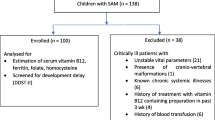Abstract
A hypothesis has been proposed that Selenium (Se) concentration in the environment as measured by its uptake by alfalfa, which sorbs Se from the soil in proportion to what is present, exerted an apparent effect on incidence of (acquired immune deficiency syndrome) AIDS such that AIDS’ mortality within the conterminous United States was lower where the Se quantity in the soil was high than where the amount was low. The object of this study was to test this hypothesis for statistical significance and to discover whether the apparent pattern of AIDS mortality in relation to Se distribution holds true with respect to all ages, both races (Black and White), and both genders. The statistical analysis employed was analysis of variance. Age-specific data as well as age-adjusted data were subject to statistical analysis. Ages where AIDS mortality rates per 100,000 were greatest were in the range from 25–54 yr for low-, medium-, and high-Se areas of the US. Black mortality owing to AIDS showed highly statistically significant results for the three Se regions, both genders, and six age groups, whereas white mortality was not as significantly affected by Se. A hypothesis is proposed that the Black population during the last decade or so has been less migratory than the White population. Thus, their food supply and hence its Se content have been more stable than that of the White population, which is more prone to consume imported foods of unknown Se content and be more migratory. A second hypothesis is advanced that suggests that medical care is not equally available to the poor and especially poor Blacks. Black men and women die at a greater death rate than do Whites. This implies that a lack of medical care is the true cause. This article suggests that a pattern exists between the geographical distribution of Se using alfalfa as a dietary guide and AIDS’ mortality such that an inverse relationship persists between Se quantity in an area and AIDS’ mortality in the same area.
Similar content being viewed by others
References
Centers for Disease Control and Prevention, 1994 Summary Notifiable Diseases, United States,MMWR,43, 15–18 (1995).
Centers for Disease Control and Prevention, 1993 Revised Classification System for HIV Infection and Expanded Surveillance Case Definition for AIDS among adolescents and Adults,MMWR,No. RR-17, 1–13 (1992).
Centers for Disease Contral and Prevention, First 500,000 AIDS cases-United States, 1995,MMWR,44, 849–867 (1995).
E. W. Taylor,Biol. Trace Element Res. 49, 85–95 (1995).
R. J. Shamberger and C. E. Willis,Crit. Rev. Clin. Lab Sci. 2, 211–221 (1971).
V. C. Morris and O. A. Levander,J. Nutr. 100, 1383–1388 (1970).
J. Kubota, W. H. Allaway, O. L. Carter, E. E. Cary and V. A. Lazar,J. Agric. Food Chem. 15, 448–453 (1967).
T. R. Shearer and D. M. Hajimarkos,Arch. Environ. Health,30, 230–233 (1975).
W. H. Allaway, J. Kubota, F. Losee and M. Roth,Arch. Environ. Health,16, 342–348.
M. Howe,Arch. Environ. Health,34, 444–448 (1979).
H. W. Lakin, inSelenium in Agriculture, USDA Agricultural Handbook No. 200, US Government Printing Office, Washington, DC., pp 3–24 (1961).
National Center for Health Statistics,Vital Statistics of the United States 1990, vol. II,Mortality, part A, Public Health Service, Washington, DC (1994).
R. R. Sokal and F. J. Rohlf,Biometry, Freeman, San Francisco, CA (1981).
N. M. Tate and R. C. Clelland,Nonparametric and Shortcut Statistics, Interstate Printers and Publishers, Danville, IL (1957).
E. Lord.Biometrica,34, 41–67 (1947).
E. Mosteller and R. R. Bush, Selected quantitative techniques, inHandbook of Social Psychology: Theory and Methods, vol 1, 289–334, Addison-Wesley, Cambridge, MA (1954).
World Health Organization,Manual of the International Statistical Classification of Diseases, Injuries and Causes of Death Based on the Recommendations of the Ninth Revision Conference, 1975 WHO, Geneva (1977).
J. Kubota, Regional distribution of trace element problems in North America, InApplied Soil Trace Elements, B. E. Davies, ed, John Wiley, pp. 441–466 (1980).
J. Kradrabová, A. Madarič, Z. Kováčiková and E. Ginter,Biol. Trace Element Res.,50, 13–24 (1995).
U. S. Bureau of the Census,Statistical Abstract of the United States, 1993, (113th ed), Washington, DC (1993).
US Bureau of the Census,Statistical Abstract of the United States, 1972, 93rd ed, Washington, DC (1972).
R. E. Chaisson, J. C. Keruly and R. D. Moore,N. Engl. J. Med. 333, 751–756 (1995).
R. S. Hogg, K. Craib, J. S. G. Montaner and M. T. Schechter,N. Engl. J. Med. 334, 123 (1996).
B. J. Turner, L. E. Markson, and T. R. Fanning,N. Engl. J. Med. 334, 123 (1996).
B. J. Turner, L. E. Markson, L. J. McKee, R. Houchens and T. Fanning,J. Acquired Immune Defic. Syndrome 7, 1250–1262 (1994).
R. E. Chaisson and R. D. Moore,N. Engl. J. Med. 334, 123–124 (1996).
R. S. Hogg, S. A. Strathdee, K. Craib, M. V. O’Shaughnessy, J. S. Montaner and M. T. Schecter,Lancet 344, 1120–1124 (1994).
R. D. Moore, D. Stanton, R. Gopalan and R. E. Chaisson,N. Engl. J. Med. 330, 763–768 (1994).
B. M. Dworkin, W. S. Rosethal, G. P. Wormser, L. Weiss, M. Nunez, C. Joline, and A. Herp,Biol. Trace Element Res. 15, 167–177 (1988).
L. Olmsted, G. N. Schrauzer, M. Flores-Arce and J. Dowd,Biol. Trace Element Res. 20, 59–65 (1989).
K. W. Beck, P. Schramel, A. Hedl, H. Jaeger and W. Kaboth,Biol. Trace Element Res. 25, 89–96 (1990).
B. W. Dworkin,Chemico-Biol. Interact. 91, 181–186 (1994).
G. N. Schrauzer and J. Sacher,Chemico-Biol. Interact. 91, 199–205 (1994).
P. S. Rosenberg,Science 270, 1372–1375 (1995).
J. C. Caldwell and P. Caldwell,Sci. Am. 274, 62–68 (1996).
Author information
Authors and Affiliations
Rights and permissions
About this article
Cite this article
Cowgill, U.M. The distribution of selenium and mortality owing to acquired immune deficiency syndrome in the continental United States. Biol Trace Elem Res 56, 43–61 (1997). https://doi.org/10.1007/BF02778983
Issue Date:
DOI: https://doi.org/10.1007/BF02778983




